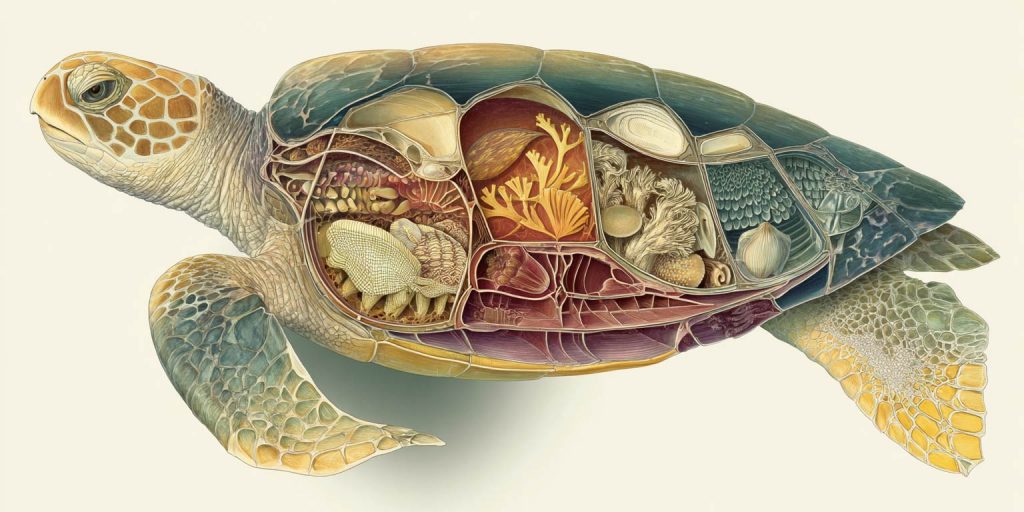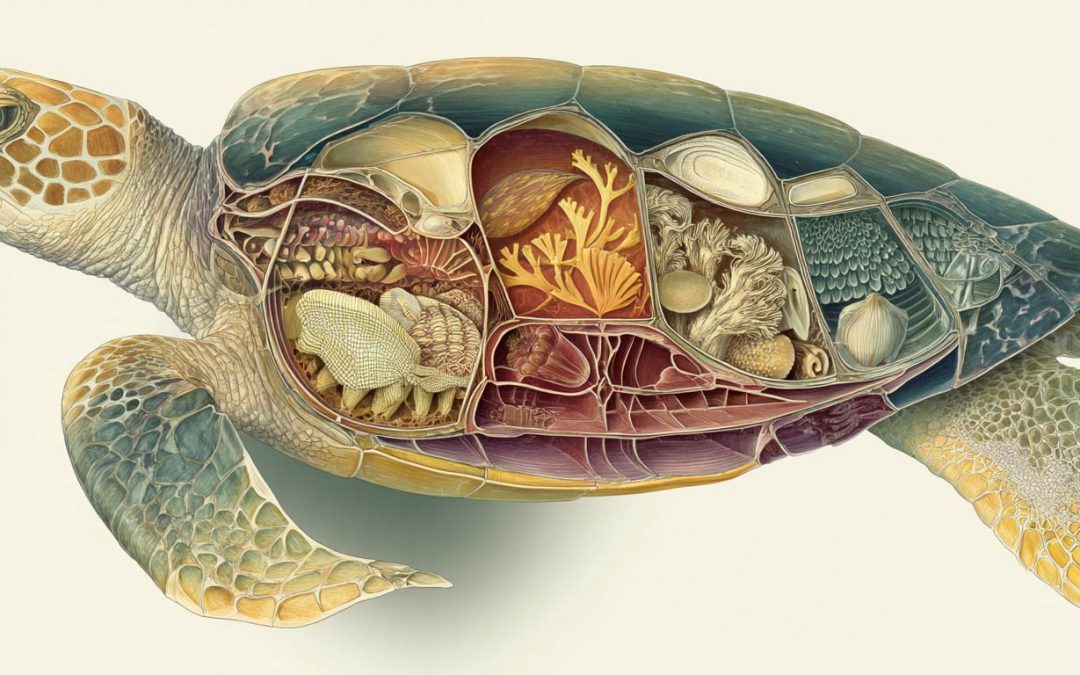Inside the Sea Turtle’s Stomach: Nature’s Food Trap

A Look at How Sea Turtles Handle Their Food
Sea turtles may seem calm and slow, but their stomachs are anything but simple. These animals have a built-in system that helps them survive in the ocean, where food can be tricky to catch and even harder to digest. From their stomach structure to how they deal with saltwater, sea turtles have unique features that make their digestive system one of a kind. Let’s break it all down, piece by piece.
Anatomy: Spiny and Specialized
The sea turtle’s stomach isn’t just a bag for holding food. It’s packed with tough, backward-facing spines called papillae. These spines cover the inside walls of the stomach and serve a critical role: they stop food from escaping once it’s swallowed.
This design is perfect for sea turtles, especially since they often eat soft, slippery foods like jellyfish. These spines grab onto the food and keep it from sliding back up.
Key Features:
- Long, narrow stomach lined with spines
- Stomach shaped to move food efficiently
- Papillae trap prey and keep it from coming back up
Cellular Composition: Built for Tough Conditions
Sea turtle stomachs are lined with thick, durable tissue that can handle rough or sharp materials. At the microscopic level, the stomach contains cells that produce mucus and acid to help break down what the turtle eats. These cells also protect the stomach lining from damage.
The spines themselves are made of keratin, the same substance found in your fingernails, which makes them strong and resistant to wear.
Function: Vomiting Water, Keeping Food
When a sea turtle swallows food, it usually takes in a lot of saltwater too. But here’s where things get interesting. Sea turtles actually vomit up all the water before starting digestion. The spines in the stomach hold the food in place while the turtle gets rid of the extra liquid.
This ability to separate food from water is essential in the ocean. Without it, turtles would be overwhelmed by all the seawater they gulp down while feeding.
Comparison with Other Turtles: Sea vs. Land
Compared to land turtles, sea turtles have a more advanced and specialized digestive system. Land turtles chew more and rely on tougher, plant-based diets. Their stomachs are simpler and don’t need the same kind of spiny protection.
Sea turtles, on the other hand:
- Swallow food whole
- Eat soft-bodied sea creatures
- Rely heavily on their stomach’s shape and spines
Digestive Transit Time: Slow but Steady
Sea turtles have a slow digestive process. It can take several days for food to pass through their system. That’s partly because they’re cold-blooded, so their metabolism runs slower.
The food goes from the spiny stomach to the intestines, where nutrients are absorbed. The entire journey can take a week or more, depending on the turtle’s size and temperature of the water.
Health Issues: When the Stomach Fights Plastic
One of the biggest problems sea turtles face today is plastic pollution. Since they often eat jellyfish, floating plastic bags can easily confuse them. Once swallowed, plastic can block their digestive tract, damage the stomach lining, or even cause starvation.
Top Stomach Health Risks:
- Plastic waste (looks like jellyfish)
- Fishing lines and hooks
- Oil and chemical spills
Greatest Threat to the Sea Turtle Stomach
Without a doubt, the biggest danger to a sea turtle’s stomach is plastic. It doesn’t break down like natural food and can get stuck inside the turtle for months or even years. In many cases, turtles that eat plastic can die from blocked guts or internal injuries.
Saving sea turtles means keeping plastic out of the ocean. It’s that simple and that urgent.
Nature Designed It Right, But Humans Are Getting It Wrong
The sea turtle’s stomach is an incredible natural tool. It’s smart, efficient, and perfectly suited to ocean life. But no matter how well it’s built, it can’t handle the damage caused by humans. Understanding how their stomachs work helps us see just how delicate and amazing these creatures are, and why they need our protection now more than ever.

